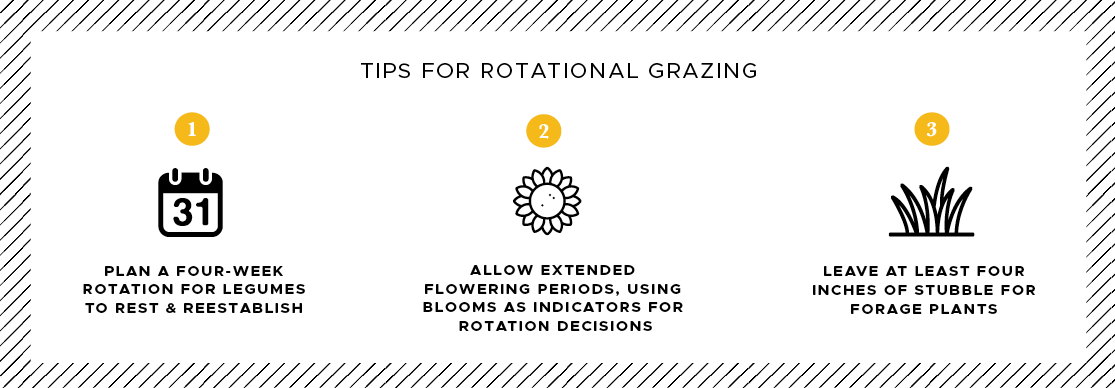Lessons Learned: Planning Pastures for Pollinator Habitat
Farmers using rotational grazing methods — allowing livestock to graze in one area while other areas recover — benefit from applying pollinator conservation to their pasture management plans.
On a diversified farm that includes field crops, berries and fruit as well as livestock, pollination services are critical for maximizing production. However, even producers not dependent on pollination have motivation to change pasture management practices. The USDA National Organic Program’s Biodiversity Guidance clarifies that certified organic operations must demonstrate how they are taking steps to enhance biodiversity and natural resources on site. In addition, diversifying a pasture’s planting plan with legumes, grasses and wildflowers, and increasing the rest period between grazing of individual paddocks, can increase pasture resiliency through the seasons and mitigate environmental pressures like drought, thus providing livestock with quality feed for a longer period.
Considerations for Plant Management
Introducing a wider variety of pasture grasses and legumes is a simple way to extend the forage season. The guide, Pastures for Profit: A Guide to Rotational Grazing, from the University of Wisconsin Extension and University of Minnesota Extension Service, explains how to combine cool and warm season grasses, and legumes, for maximum productivity. For instance, cool-season grasses and legumes follow a complementary growth pattern and ought to be separated from warm-season grasses for optimum pasture health during livestock rotations.
Establishing a diverse mixture of plants is key for creating a manageable and high-quality pasture for grazing. Forage legumes offer benefits for livestock—a nutritional profile with higher crude protein and mineral content—and a consistent source of nectar and pollen for pollinators.
A few simple steps can help optimize pasture health for farm animals and bees:
- Add flowering plants to pasture plantings
A mixture of perennials like clovers (red, Ladino and Alsike) alongside alfalfa offers a high-quality pollen resource for pollinating insects. The University of Vermont’s Sid Bosworth points out in the Forage Legume Bee Project’s resource, Developing a Bee-Friendly Pasture System, that the type of forage legume is less important to bees than finding the right varieties for your region. Ease of seeding, plant establishment and value to livestock all should be deciding factors on what legume is best for your pasture. - Plant during winter for optimal conditions
Seeding pasture at the right time can be the difference in establishing successful stands of mixed forage. Competition from grasses and weeds, for example, can crowd out a legume’s ability to germinate. Bosworth recommends “frost seeding,” a method of over seeding in late winter to take advantage of soil heaving during freeze and thaw cycles. Look for open areas in heavily-grazed paddocks. These are often fertile ground where seeds can easily reach the soil. This method takes advantage of natural forces, minimizing the need for tillage or drilling. If unable to plant during winter or if pasture grasses prevent seeds from getting to the soil, some tilling or use of a no-till drill might be necessary to ensure good seed-to-soil contact. Timely mowing or grazing after planting can also help give young seedlings a competitive boost. Perennial forage legumes are excellent self-propagating plants, but periodic reseeding may be necessary to maintain a balanced mix.

Rotational Management
Timing livestock access to pasture areas is also an important part in creating habitat for native bees. If legumes and other plants aren’t allowed to flower, or flower for a long enough period, pollinators won’t have a steady food source.
Good livestock rotation protects pasture areas (paddocks) from overgrazing and provides them enough time to rehabilitate and reestablish. A pollinator-minded grazing system just extends these core concepts a bit further, including:
- Maintain flowering areas throughout the season
Allowing plants to regrow and flower provide food for pollinators. Paddocks will be in various stages of regrowth as livestock move throughout the pasture, following a predetermined pattern based on plant types, regrowth rates and accessibility. The point is to have flowers available somewhere at all time throughout the season. - Avoid overgrazing and watch timing in rotations
Rotation management seeks to prevent livestock from having access to all parts of the pasture throughout the year. Yet even with rotation planning, it’s important that animals not graze legumes before they’ve had a chance to flower. Pasture paddocks require careful management of grazing intensity and duration to avoid weakening plants and thus reducing highly nutritious food sources for livestock and bees.
Pastures for Profit: A Guide to Rotational Grazing provides general guidelines, including:
- The higher the stubble of forage plants, the faster that pasture area will recover. A good rule of thumb is to leave at least four inches for cool-season grasses and legumes, while leaving four to eight inches for warm-season grasses. This decreases the risk of plant damage and lessens the need to reseed.
- Allow flowering periods for legumes to extend as long as possible within your rotation, making certain that other paddocks are flowering before allowing livestock to return to an area in bloom.
- Consider at least a four-week rotation between paddocks to allow for regrowth and legume bloom. Legumes typically need three to four weeks of rest to reestablish, while cool season grasses—ryegrass, timothy, orchardgrass—need two weeks in cool weather and as many as five to seven weeks in hot weather.
- Always use blooms as the main indicator for making rotation decisions for pollinator habitat and health. Take your pasture and number of animals, and divide into paddocks that allow for four- to eight-week rest periods before returning animals to a paddock.
USDA NATURAL RESOURCES CONSERVATION SERVICE (NRCS)
The NRCS can provide both technical and financial support for producers interested in a more intense rotational management strategy for livestock and pollinator health. They can help design a grazing plan, provide funding for fences, help set up watering stations for animals and provide technical expertise for rotational strategies for your conditions and specifications. Visit: nrcs.usda.gov
